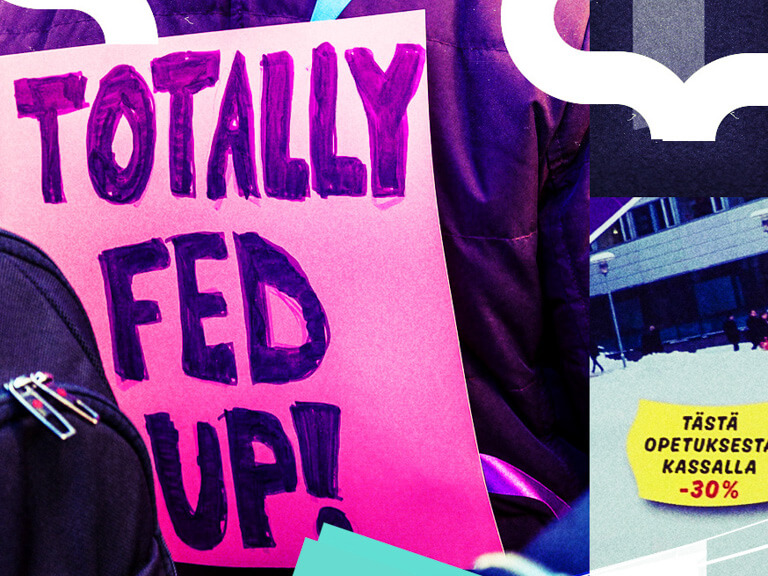Twelve years ago, the Finnish universities signed the first collective agreement of their own. According to university representatives, this agreement is not perfect but essential regardless. Early next year, the agreement will be on the table once again, and the negotiations are expected to be even more challenging than usual — again.
The negotiations concluded the night of 9–10 March 2010. Perhaps appropriately, the cloudy night had given way to a clear, bright morning in Kaisaniemi, Helsinki.
Finnish Union of University Researchers and Teachers Executive Director Eeva Rantala recently wrote in Acatiimi that the negotiation result secured the terms of university personnel employment. In addition, Rantala determined that staff associations had achieved their primary goal.
The negotiations had not progressed particularly smoothly. Quite the opposite, in fact —such a dispute was unprecedented. The agonising spat had been ongoing since the late autumn of 2009.
The university reform took effect at the start of 2010. The universities were no longer accountancy offices and became independent legal entities, separate from the central government. This also meant their personnel went from civil servants to employees. The universities would continue to be funded by the state, but now all negotiations regarding employment conditions would be held with the Association of Finnish Independent Education Employers (YOL), a member of the Confederation of Finnish Industries (EK), instead of the Ministry of Education and Culture as before.
Trade unions strongly opposed the idea of leaving civil service relationships behind but lost.
A month passed from the university reform, and still no agreement between the universities was forthcoming. The negotiations, too, had stalled. University personnel would have preferred to keep the terms that had been agreed with the state, but YOL wanted weaker terms.
“The parties were extremely divided. Those of us on the employee side would have been fine with the same civil servant contracts and collective agreement with a few changes. Just write University Collective Agreement on the cover and be done with it, but the employer side wanted to change every single thing”, says Tarja Niemelä. In 2010, Niemelä was negotiating on behalf of JUKO, the Negotiation Organisation for Public Sector Professionals. Currently, she serves as the Executive Director of the Finnish Union of University Professors.
The employers offered written proposals, only for the employees to revert every change one at a time.
“It was a game of cat and mouse.”
The situation was further exacerbated by the fact the state’s collective agreement negotiations had also stalled. It had been agreed that increases from the state negotiations would be transferred to university budgets.
The decisive move of the game was finally made by the employee side. On the third of March, the primary negotiators, the three university personnel unions — JUKO, the Pardia trade union, and the Trade Union for the Public and Welfare Sector JHL — marched into the National Conciliator office and Eteläranta to declare a labour dispute starting at midnight on March 18 and lasting for one day, unless an alternative agreement could be made.
The unions stated their willingness to compromise had reached its limit. The employer’s “salary offer” was considered an insulting excuse for an offer.
Minister of Education Henna Virkkunen (NCP) described the reform as “the second-best thing to happen to the universities since their foundation”. With a strike, university personnel’s discontent towards the important and even “fantastic” reform would have flared up further.
The state negotiations were finished on Tuesday, 8 March. It was easy for the universities to follow suit.
After the negotiations finished, Eeva Rantala wrote in a press release that 1,600 total working hours now applied to researchers. While both sides wanted total working hours — the alternative would have been the maximum of eight hours per day, in accordance with the Working Time Regulations — agreeing on the details had been the primary question and source of conflict. The salary system did not change in any appreciable way and raises also remained the same as with the state.
“Most in the researcher community were happy about this move to total working hours. It meant freedom from timecards”, says Tarja Niemelä.
Niemelä gives the employer representatives credit as well.
“Civil servants and employees previously got different amounts of sick pay. Our proposals regarding that were accepted down to the smallest detail.”
And that, as they say, was that. The framework for the entire decade had been cemented. That framework has largely held steady since then.
The year 2010 and the university reform were a turning point in Finnish university history, but those days now seem rather distant and even more innocent.
The first foundation universities — the Aalto University and the Tampere University — had just begun operations. Professors lacked career paths and were assisted by a larger number of administration personnel than today. The COVID-19 pandemic and distance learning were still far in the future. The 1,600 total working hours did not include the so-called “kiky hours” (kiky, kilpailukyky=competitiveness) of Juha Sipilä’s (Cen) government.
Since the first new agreement, collective agreement negotiations have been held five times, with the opposing YOL side changing their name to the Finnish Education Employers (FEE) in 2010. The sixth round of negotiations approaches this winter. Usually, the negotiations have taken place at FEE in Eteläranta, with the employer serving coffee and buns.
Collective agreement changes have not been readily visible within the universities’ hallways. As such, let us fast-forward through the agreement phases and changes:
2012: Pay raises in accordance with the general framework, and fine-tuning teaching responsibilities of doctoral students.
2014: Salary reviews.
2016: The addition of kiky hours and an option for a local agreement in the event of a financial crisis situation.
2018: Adjustment of salary levels and job requirement scheme and changing performance levels (to determine personal salary elements) to performance categories.
2020: Negotiations completed in record time, with free kiky hours removed (although Anne Somer, FEE’s Labour Market Director at the time, declared the employee side’s demands for pay raises to be “threats” before the negotiations even started)

However, something was seething under the surface. The reality brought by the university reform had begun to reveal itself.
“Not a single thing in the collective agreement negotiations involved the employer striving for staff well-being or decent staff policy. They just ruthlessly tried to do everything in their power to weaken the employee’s position”, says Chief Shop Steward Antero Puhakka from the University of Eastern Finland. Puhakka was part of the background group for the 2010 negotiations and had previously served as the President of FUURT.
When drafting the university reform, the parliament’s Education and Culture Committee had outlined the reduction of fixed-term contracts and a good staff policy as the goals for the reform. Puhakka is especially frustrated by the employer’s attitude towards the fixed-term issue. The old collective agreement for public officials had been amended in 2006 with the obligation to assess the fixed-term situation together with trade unions.
“This was one of the first things the employer wanted removed from the collective agreement”, Puhakka says.
Currently, 70 percent of teaching and research personnel work under fixed-term contracts, even though the publicly stated goal of the university reform was something very different. In university administration, three out of four employees work full-time.
Puhakka describes the increase in fixed-term employment as “horrible”. In his opinion, many are too committed to their jobs, putting in as many as 400 hours of overtime on top of their annual total working hours. Investigations have revealed this number to be as high as 600–700 hours for professors. This makes improving employee benefits more difficult. The state has begun to demand more from the universities than before, but the only way to meet those demands has been unpaid overtime. This volunteer labour, in turn, helps hide the conflict between the demands and available resources.
“When kiky increased working hours by 24, I laconically commented that now we’re only doing 376 hours of unpaid overtime.”
In 2018, the collective agreement negotiations spiralled into crisis. Over a month passed without a new agreement, and the University of Helsinki went on strike for the last day of February. This was the first professors’ strike in Finnish history.
“What was the problem? Well, these things tabled in the 2010 reform, of course”, Puhakka says.
Puhakka got the impression FEE had sent their “second line men and women” to negotiate. There were no university heavyweights on the labour market committee. (Generally, turnover has been significant on the employer side. Labour Market Director Hanne Salonen, who will carry out next year’s negotiations, started in her position this October. Labour market lawyer Joona Kaunisniemi, responsible for dealing with the universities, moved to FEE from Taksiliitto slightly over a year ago.)
“The whole negotiation setup looked really bizarre to an outside observer. Who’s doing what here? What’s their mandate? No one really seemed in control.”
The salary system was a particularly major point of contention. The university people reckoned the system did not adequately recognise teaching merits. FEE did not want to open up the job requirement table or descriptions. Furthermore, the Finnish Union of University Professors pointed out that the system did not recognise professors on tenure tracks.
At the same time, the universities demanded the removal of upper limits for teaching hours and refused to agree to pay raises equivalent to the export industries, despite the universities not making a deficit. “Playing hardball”, Union for University Teachers and Researchers in Finland (YLL) chair Santeri Palviainen describes the situation.
The picture was complicated further by codetermination negotiations and other crystallisations of the Sipilä government’s university cutbacks.
Not much common ground could be found, with the exception of the salary system becoming flexible with the removal of the personal performance levels. Everything else was in such disarray that the conflict was swept under the rug by the negotiation result. Working groups were formed for revising the salary system and for fixed-term employment contracts.
The most unpleasant fundamentals from the employee perspective have resulted from the university reform, and no amount of complaining is going to change that. In October’s Acatiimi, Minister of Science and Culture Antti Kurvinen (Cen) stated that the Universities Act is not going to be opened up, certainly not during this government’s term. Because of this, the disputes in the first decade of the new collective agreement, since the beginning, have culminated in the issue of maximum teaching hours.
Essentially, the issue is the maximum number of hours that may be included in the total working hours. The ceiling for professors is currently 141 hours, whereas the maximum for lecturers sits at 394 hours. YLL’s Parviainen reckons those teaching at language centres or teacher training colleges are the most likely to scrape against the ceiling.
The employer wishes to raise this ceiling or remove it altogether, whereas the major employer side organisations FUURT, Finnish Union of University Professors, and YLL are doing all they can to stop such demands.
“When FEE came to negotiate, they claimed that we’re talking about a full hour, when a university lecture is traditionally 45 minutes. That would have added a full third”, says Antero Puhakka.
“The working hours agreement had been in effect since 1992. Suddenly, we had to spell out what an hour means.”
According to Tarja Niemelä, the 2010 negotiations began to untangle themselves once the dispute over maximum hours was settled — to the employee side’s advantage, she reckons.
“The wording was changed a bit, but in reality, it didn’t change in any way”, she says.
Very good. The maximum hours were retained. But that was merely the start. Throughout the decade, a consensus on what constitutes teaching has been sought. Does advising a student on their thesis count? How about multi-disciplinary, distance, in-person, hybrid teaching?
According to YLL’s Santeri Palviainen, there are varying interpretations amongst employers as well.
“The employer has had an interpretation prerogative here. Our opinion is that these should be counted as teaching work.”
Antero Puhakka states his opinion in a more direct manner:
“The employer apparently wants teaching 24/7, 365 days a year.”
When the COVID pandemic hit and distance learning began, the ambiguity of the situation smacked everyone across their knuckles. FUURT Director of Advocacy Mia Weckman says employees were prepared to work even in their free time to allow university lessons to continue through the pandemic.
“Haven’t got very much recognition for that.”
According to Tarja Niemelä, some universities are interpreting the collective agreement incorrectly. According to their policies, compensation for extra teaching work may only be received when the maximum number of hours has been reached. The Finnish Union of University Professors is of the opinion that this additional compensation must be paid as soon as extra hours are taught outside the work plan.
“If I was a professor and, after teaching two courses, had to teach a third one not listed on the work plan, I should be compensated according to the collective agreement. That is, unless the situation allows for removing an equivalent amount of work from the plan”, she says.
During COVID, there has been a lot of volunteer teaching work. Compensation has not been demanded, offered, or paid in the amounts extra compensation should be.
All interviewees emphasise that the employer side mainly considers the maximum amount of teaching, with everything else on top of that.
“You have to be able to do research outside evenings, weekends, and the summer”, Niemelä says.

University education has become mass education in Finland. The goal of the state is to get half of the generation through higher education in 2030. The number of teaching and research personnel is on a slight increase, but according to Tarja Niemelä more are required in order to achieve the objectives.
The universities are faced with a zero-sum game known as budgetary constraints. According to our interviewees, more and more is demanded from employees as admittance numbers grow, but this is not reflected by university budgets. Whilst the universities have to decide what they can afford in terms of time and money, the government has made its priorities clear — and they do not involve research.
Niemelä says there is no extra manpower or loose resources. The existing staff is limited, and their duties cannot be endlessly rearranged, no matter how much the universities and the ministry wish that was possible.
“The big issue the universities face is how to provide quality education. In truth, it means more resources are needed. Regardless of whether the collective agreements improve”, says Niemelä.
So, what should one do in a situation where the collective agreement says one thing and reality refuses to agree?
Antero Puhakka sighs deeply. In the 1990s, the collective agreement dictated that teachers are not covered under the Working Time Regulations. In practice, only results are measured, not time. Puhakka explains this means it is extremely difficult to draw a line where a violation begins. He still regularly meets new researchers asking about their teaching obligations — despite the fact the practice has been abandoned in Joensuu three decades ago.
“Because of that, it’s hard to say the collective agreement is being violated. It says the employee is responsible for their own working hours. However, collective agreement rulings are perfectly fine as long as people are able to comply. In reality, they aren’t, and that’s where the problem lies.”
University of Eastern Finland (UEF) docent and former Central Organisation of Finnish Trade Unions (SAK) senior researcher Tapio Bergholm, an expert on the Finnish trade union movement, says there is nothing historically unprecedented about compromising on collective agreements. The same has been done in several industries including paper, chemistry, and transport. In several decades, too — especially from the 1970s to the 1990s, and during the zero-growth period in the 2010s. Employees have participated voluntarily without explicit compensation because “there is no local negotiating power”, as Bergholm puts it.
At the same time, industrial action expertise has deteriorated, and it appears no one in Finland knows how to organise or deal with workers’ strikes anymore. Unresolved conflicts become sticking points.
Bergholm observes similar situations at the universities and his words to the employee side are not particularly optimistic.
“In terms of the universities, it seems the amount of money per student has decreased, there is a surplus of skilled doctors, and the growth of the field is under tension. This is an oversupply situation, which means the employer’s got plenty of opportunity and temptation to demand flexibility from the employees”, Bergholm says.
“As a result, each employee’s negotiating position as individuals is very weak, which is of course an unreasonably Marxist interpretation.”
The employer has taken notice. For example, the flexible personal salary introduced in the 2018 amendment made leadership and organisation more difficult once again. Decisions should be contested with your own name and face and the processes are agonisingly slow, which makes creating precedents at labour courts rather difficult. If a career-oriented, highly educated modern city dweller gets to choose whether to progress their career or gripe about their rights, most would choose the first option. During his time as SAK’s equality representative, Bergholm noticed a relative lack of equality cases compared to the state. However, that did not mean the state had more issues with equality as an employer.
“As a state employee, you could complain without destroying your career. That is why talented women advanced their careers there instead of the private sector.”
For many researchers, the professor tenure track is the opportunity of a lifetime — which, naturally, means glossing over how that path relates to labour law.
The tenure track system has been in use for years, with professors increasingly being recruited at the lower levels as assistant or associate professors. Collective agreements still do not recognise the tenure track, as the system was yet to be adopted in Finland when the Universities Act was being written.
“This is one matter that should be discussed with FEE. Since 2020, we have had a working group handling the issue”, Tarja Niemelä says.
Antero Puhakka does not expect collective agreement clauses to be able to solve the tenure track deadlock. Illegal is what it is.
“No question about it. They are completely illegal. Tenure contracts are just illegally lengthy probationary periods”, he says.
According to Puhakka, this is about attitude — and an attitude adjustment being necessary. The employers could stop with their grandiose speeches in which “our staff is our greatest strength” when they are unwilling to show even the slightest hint of appreciation at the negotiation table.
University workers should realise they are employees and act accordingly. In the October issue of Image, linguist Janne Saarikivi wrote about the end of his professorship and stated that nobody wants to start a revolution because in the modern world and university, everyone is an individual competing with others, lacking class identity.
This is fuelled even further by the universities’ internationalisation craze, which does not coexist well with advocacy. When a researcher from a country with less comprehensive collective agreements arrives in Finland, they are in a vulnerable position from the start and likely not the first one to fight for their rights.
“In that situation, can you afford solidarity with others?” asks Antero Puhakka.
But what good is a collective agreement that lacks fundamentals and is constantly ignored, with even employees themselves not complying with it?
“It’s the only one we’ve got”, Puhakka says.
According to Puhakka, in traditional trade union politics, one way to get the employer to accept better terms has been to only do the kind of work and the amount of work you are paid for. At that point, it would be revealed that things are not working.
“It is the safe option we can lean on if problems arise. Its existence is absolutely necessary. It doesn’t make any sense to start local negotiations over working hours or salaries or that sort of thing in a country the size of Finland. At least we’ve got enough sense to realise that.”
Finnish Education Employers CEO Teemu Hassinen does not agree with the union representatives’ views regarding the university employment terms being worse than those dictated by the collective agreement. Hassinen says the universities comply with the collective agreements.
“I must say I do not recognise the problem.”
Hassinen declines to comment on the unpaid overtime of university personnel. He states he “recognises the researchers’ high level of commitment” but the issue is not mentioned in FEE statistics.
Hassinen does believe the world has changed quicker than the universities’ collective agreement has been able to keep up with. According to him, university work has diversified, which is why carrying it out in a more flexible manner is required. However, this problem occurs on a wider scale in our collective agreements and is primarily a result of the nature of work changing due to technology. Hassinen does not comment on the increase in fixed-term employment. In his view, fixed-term employment is not “a totally simple matter” but dependent on the university environment and “parameters”. However, care must be taken to ensure valid grounds for fixed-term contracts and related processes, Hassinen says.
But what is a universally binding collective agreement needed for in his opinion?
It offers a framework for working, leadership, and organisation, along with security for the staff, Hassinen lists.
“Collective agreements still have their purpose as long as they can be developed”, Hassinen says.
But how? Hassinen is reluctant to talk about FEE’s future negotiation objectives, although “develop” is frequently used as a euphemism when something is to be cut or reduced.
He stresses that “strong trust” between the negotiating parties is his most important message.
Antero Puhakka expects the upcoming negotiations to turn out exceptionally difficult. The setup will be the same as it has always been, he believes: the employer wants to weaken the terms and the employees reject that to the best of their ability.
The employer buys peace and quiet. That is what we sell”, Puhakka says.
FUURT’s Mia Weckman also believes there is a certain amount of pressure to negotiate for more than “a financial solution”. She tells us their members have been concerned about equality, shop steward positions, and workplace well-being. The “perpetual favourite child”— the fixed-term situation — also falls under the latter.
“Our long-term goal has been to turn it around: 70 percent full-time and 30 percent fixed-term.”
The Finnish Union of University Professors looks to improve the research period system. YLL is concerned about in-person learning regulations. But these are merely nuances. Our interviewees reckon that the wishes of every union in JUKO are largely aligned despite the significant range of duties and salaries.
However, a successful negotiation can be interpreted in two ways. The glass may be half empty or half full.
“A good negotiation is one that both parties can be satisfied with afterwards”, says YLL’s Santeri Palviainen.
Tarja Niemelä views the situation somewhat differently.
“When both parties are slightly dissatisfied, the solution has been good”, she says. •
Risto Laitinen, former chair of the Finnish Union of University Professors, was also interviewed for this article.

The article has been originally published in Acatiimi 06/21.
Text: Oskari Onninen
Illustrations: Hans Eiskonen
Photos: Milla Talassalo
Translation: Marko Saajanaho



